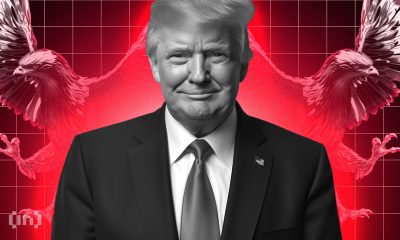Market
ChainGPT Founder Expects AI Agent Adoption to Transform Crypto

Industry experts expect AI agents to benefit the crypto market and blockchain ecosystems extensively. These autonomous systems can improve investment strategies and execute trades more effectively while detecting and mitigating threats.
BeInCrypto spoke with ChainGPT Founder Ilan Rakhmanov about the industry areas AI agents will most profoundly affect and the risks that need to be addressed for the safe deployment of these emerging technologies.
The AI Agents Market is Surging
AI agents represent a fundamental shift in the evolution of blockchain technology and the cryptocurrency market. These autonomous systems make decisions and perform tasks independently.
They can enhance intelligence, adaptability, and fairness in financial mechanisms. Unlike AI bots, AI agents adapt to tasks and handle multi-step processes with goal-oriented autonomy.
“We believe that, in 2025, we may see the first AI agents “join the workforce” and materially change the output of companies. We continue to believe that iteratively putting great tools in the hands of people leads to great, broadly-distributed outcomes,” wrote OpenAI CEO Sam Altman in a blog post earlier this month.
In a recent report, asset manager Franklin Templeton also underscored the merits associated with AI agents.
“We can envision a future where Al agents revolutionize content generation on social media and play an integral role across various industries and platforms. Like today’s human influencers, these agents could launch their own brands, products, music, movies, and more, driving significant economic value to their ecosystems,” it read.
According to CoinGecko, AI agents took off as a market category shortly after Truth Terminal’s GOAT token launched on Solana last October. Currently, AI agent tokens have a market cap of more than $12 billion.
This is remarkable growth considering the fact that the majority of this market segment didn’t exist a year ago.

Currently, over 150 crypto tokens used for AI Agents are listed on CoinMarketCap. This number represents the surge in AI agent-related projects and their promise for the sector’s future.
AiXBT, ai16z, Virtuals Protocol, and Zerebro are among other notable examples. AI platforms like ChainGPT, Dall-E, and Midjourney are also driving innovation in the sector.
Given this dynamic growth, it’s safe to say that AI agents will continue to drive change in the dynamics of AI and crypto-related industries as adoption accelerates.
Changes in the way Crypto Markets Function
While last year saw these autonomous systems primarily used for content creation and social media engagement to generate attention, AI agents in crypto trading might be a defining trend in 2025.
Though AI agents share some functionalities with AI trading bots, they represent a more advanced level of technology.
For instance, a defining characteristic of crypto AI agents is their inherent autonomy. This characteristic allows them to operate independently. AI agents can continuously monitor market conditions and execute actions based on pre-defined parameters without requiring constant user intervention.
This level of autonomy distinguishes crypto AI agents from traditional trading bots. So, they can effectively function as self-reliant assistants for managing cryptocurrency portfolios and executing trading strategies.
“AI-powered trading bots are changing the way crypto markets function. They offer fast, precise, and data-driven decision-making. They can analyze market trends, execute trades, and manage portfolios far more efficiently than humans while also helping to reduce emotional decision-making,” Rakhmanov told BeInCrypto.
A key feature distinguishing these tools is their ability to learn from historical market data and continuously refine their predictive models.
This machine learning capability enables automated trading systems to operate continuously, identifying and capitalizing on trading opportunities that may not be instantly apparent to human traders due to limitations in time and attention scope.
Also, the capabilities of AI agents spill over to other areas of the cryptocurrency ecosystem, such as DeFi protocols.
Simplifying DeFi Protocols
AI agents’ ability to carry out tasks at rapid speeds makes them a critical tool in the decentralized finance (DeFi) sector.
“AI has become a household name, and its impact is now reaching the world of decentralized finance (DeFi). By automating and optimizing processes, AI is making DeFi smarter and more efficient,” said Rakhmanov.
Crypto AI agents operate based on a three-step process: data collection, data analysis, and automated execution. In the first step, the AI agent collects substantial data from various sources, including market trends, blockchain transactions, and DeFi statistics.
This data is then analyzed using advanced machine learning algorithms and predictive analytics techniques to identify patterns and determine the optimal course of action.
Finally, based on this analysis, the AI agent autonomously executes the determined actions, such as placing trades, moving funds between wallets, or triggering the execution of smart contracts.
“AI can improve risk assessment in lending protocols by evaluating borrowers more accurately, leading to better decision-making. It can also make liquidity pools work smarter by predicting user behavior and market trends, reducing waste and inefficiencies. Additionally, AI can enable smart contracts to adapt to real-world changes automatically, without needing human input,” Rakhmanov added.
By doing so, these AI agents greatly facilitate DeFi interaction.
“These innovations are making DeFi systems not only more effective but also more accessible and user-friendly, paving the way for broader adoption by people from all walks of life.”
Beyond their appeal to institutional investors or professional traders, AI agents can be leveraged to attract a wider audience to Web3 technologies in general.
AI Agents Increase Accessibility for Users
Autonomous agents could make the industry more accessible by fundamentally breaking down complex mechanisms and automatically executing them.
“AI Agents can simplify interactions by providing real-time insights, educational tools, and personalized guidance tailored to each user’s needs. For instance, AI-powered assistants could explain complex DeFi protocols in plain language or recommend optimal investment strategies,” Rakhmanov told BeInCrypto.
They can be vital tools for inexperienced users because they can adapt to individual use cases.
“By prioritizing user-centric design and leveraging AI, the cryptocurrency ecosystem can attract a broader audience and lower barriers to entry,” he added.
AI agents can also make the onboarding process easy for new users. If they were to spread globally, such systems could incentivize widespread adoption, according to Rakhmanov.
“The convergence of AI and blockchain could democratize access to financial systems, empower individuals with tailored tools, and enhance financial inclusion globally. Economically, AI-driven automation could reduce inefficiencies, lower transaction costs, and unlock new markets. Socially, decentralized AI systems like Decentralized Artificial Superintelligence (DASI) could promote fairness and reduce bias in financial decision-making.”
Leveraging Security and Scalability
AI agents have a completely different and more nuanced use case in terms of blockchain security. They can enhance the security and scalability of the entire blockchain network, safeguarding both experienced and inexperienced users from associated risks.
The security framework ensures the agent operates safely, protecting user data, private keys, and executed transactions.
Crypto AI agents incorporate thorough security measures, including encryption and multi-layer authentication, to ensure the security and privacy of user data.
“On the security front, they can detect and mitigate threats in real-time by analyzing patterns and identifying anomalies, reducing vulnerabilities to hacks and fraud,” Rakhmanov explained.
A blockchain integration layer connects the agent to blockchain networks, enabling it to interact with smart contracts, wallets, and DApps. It bridges the agent and the blockchain, ensuring the agent can operate across multiple ecosystems.
The blockchain integration layer enables the agent to function seamlessly across multiple blockchains. This layer acts as a bridge connecting the agent to these networks and facilitating interoperability.
“For scalability, AI Agents can optimize resource allocation, improve consensus mechanisms, and streamline data validation processes,” he added.
However, there are also associated security risks that come with AI agent integration. Given their autonomous nature, crypto AI agents are susceptible to cyberattacks.
Potential vulnerabilities include smart contract exploits, private key compromises, and the possibility of market manipulation.
Therefore, a strong security framework is essential.
Blockchain network congestion, characterized by delays and increased transaction fees, can hinder the performance of crypto AI agents. This issue is common on blockchains like Ethereum during periods of high activity.
Integrating crypto AI agents across different blockchains can also be challenging. This is due to each network’s varying protocols and decentralized infrastructures.
Other Associated Challenges With AI Agents
The benefits and potential of AI agents are evident. Yet, the technology is in its early stages, and there are more limitations to consider.
While the autonomous capabilities of AI agents offer significant advantages in terms of efficiency and responsiveness, they also raise important questions regarding accountability and risk management.
“These advancements also pose risks, including job displacement and ethical concerns around data privacy,” Rakhmanov told BeInCrypto.
An autonomous AI agent’s actions can sometimes lead to unintended consequences, such as market instability. Determining responsibility and establishing accountability mechanisms in such situations can be challenging.
“As these bots become more common, they could make the market more volatile since they react instantly to price changes. To ensure everyone benefits, we’ll need to strike a balance between embracing innovation and putting in place thoughtful regulations,” he added.
The performance of AI agents is highly dependent on the quality of real-time data. Challenges such as inaccuracies in data provided by blockchain oracles and potential errors within smart contracts can significantly impact their decision-making capabilities.
“Decentralization helps mitigate some risks by removing single points of failure, but robust governance, transparency, and ethical AI design are essential to minimize unintended consequences,” Rakhmanov said.
Furthermore, constantly changing international regulations surrounding blockchain and AI present significant challenges for developing and deploying crypto AI agents.
This context raises important questions regarding AI agents’ legal and regulatory compliance, particularly those engaged in financial operations such as trading and DeFi interactions.
“Proactive collaboration among stakeholders, including regulators, technologists, and communities, will be crucial to ensure equitable benefits for all.”
Given that these agents are only the tip of the artificial intelligence iceberg, addressing these challenges early on will prove vital for the effective and responsible development of these emerging technologies.
Disclaimer
Following the Trust Project guidelines, this feature article presents opinions and perspectives from industry experts or individuals. BeInCrypto is dedicated to transparent reporting, but the views expressed in this article do not necessarily reflect those of BeInCrypto or its staff. Readers should verify information independently and consult with a professional before making decisions based on this content. Please note that our Terms and Conditions, Privacy Policy, and Disclaimers have been updated.
Market
Report Alleges Massive Meme Coin Sniping on Pump.fun

According to a new report from Pine Analytics, token deployers on Pump.fun systematically funded sniper wallets to buy their own meme coins. This impacted over 15,000 token launches on the platform.
These sniper wallets operated primarily during US trading hours, executing standardized, profitable strategies. Unrelated bot activity obscures their behavior, making it extremely difficult to isolate these wallets—and they can readily adapt to new countermeasures.
Snipers Roam Free on Pump.fun Meme Coins
Pump.fun has remained one of the most popular meme coin launchpads on Solana despite persistent controversies and other criticism.
However, Pine Analytics’ new report has uncovered a new controversy, discovering systematic market manipulation on the platform. These snipes include as much as 1.75% of all launch activity on Pump.fun.
“Our analysis reveals that this tactic is not rare or fringe — over the past month alone, more than 15,000 SOL in realized profit was extracted through this method, across 15,000+ launches involving 4,600+ sniper wallets and 10,400+ deployers. These wallets demonstrate unusually high success rates (87% of snipes were profitable), clean exits, and structured operational patterns,” it claimed.
Solana meme coin deployers on Pump.fun follow a consistent pattern. They fund one or more sniper wallets and grant them advance notice of upcoming token launches.
Those wallets purchase tokens in the very first block and then liquidate almost immediately—85% within five minutes and 90% in just one or two swap events.
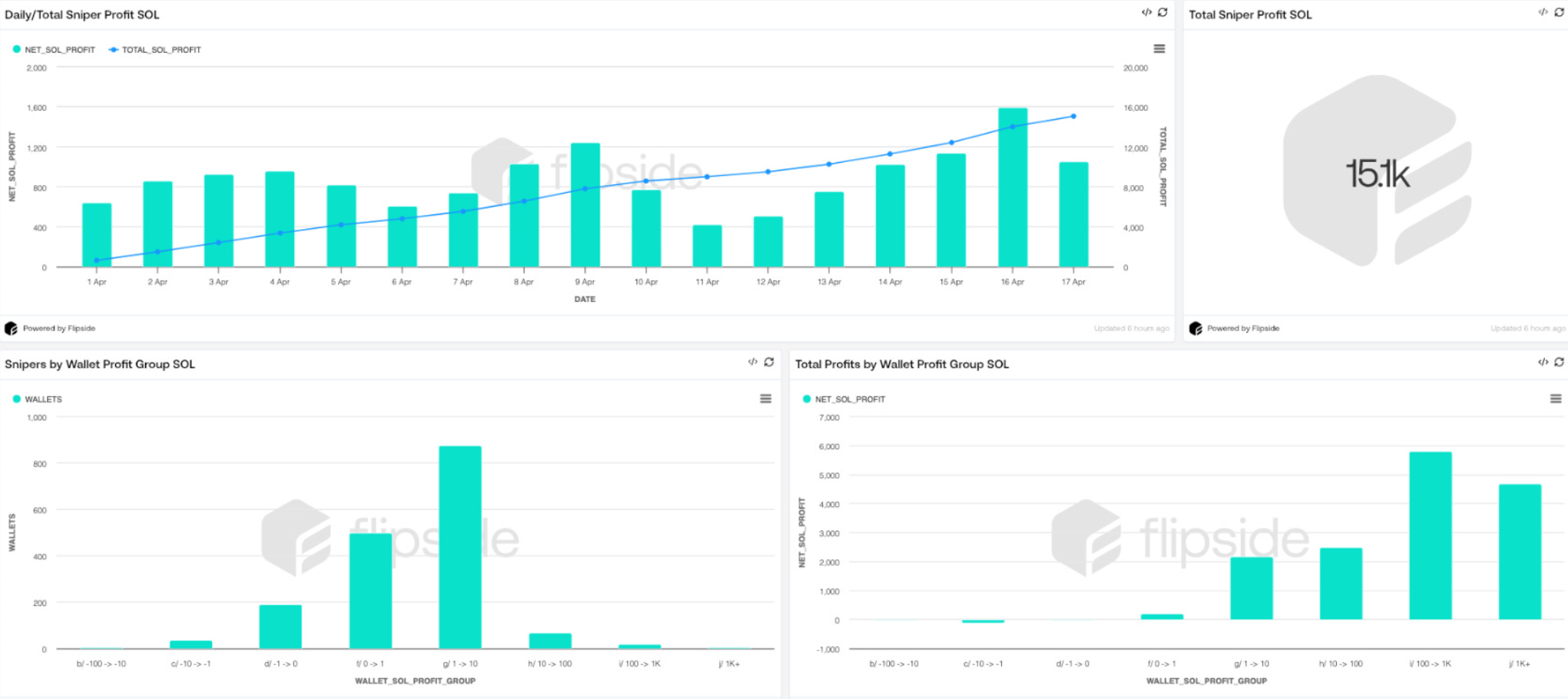
Pump.fun meme coin developers exploit this tactic to create the appearance of immediate demand for their tokens. Retail investors, unaware of the prior sell‑off, often purchase these tokens after the snipe, giving developers an unfair advantage. This constitutes market manipulation and erodes trust in the platform.
Pine Analytics had to carefully calibrate its methods to identify genuine snipers. Apparently, 50% of meme coin launches on Pump.fun involve sniping, but most of this is probably bots using the “spray and pray” method.
However, by filtering out snipers with no direct links to developer wallets, the firm missed projects that covered their tracks through proxies and burners.
In other words, the meme coin community does not have adequate defenses against systematic abuse on Pump.fun. There are a few possible ways that the platform could flag repeat offenders and sketchy projects, but adaptive countermeasures could defeat them. This problem demands persistent and proactive action.
Unfortunately, it may be difficult to enact such policies. Meme coin sniping is so systematic that Pump.fun could only fight it with real commitment.
Analysts think that building an on-chain culture that rewards transparency over extraction is the best long-term solution. A shift like that would be truly seismic, and the meme coin sector might not survive it.
Disclaimer
In adherence to the Trust Project guidelines, BeInCrypto is committed to unbiased, transparent reporting. This news article aims to provide accurate, timely information. However, readers are advised to verify facts independently and consult with a professional before making any decisions based on this content. Please note that our Terms and Conditions, Privacy Policy, and Disclaimers have been updated.
Market
Solana Leads Blockchain Metrics as SOL Momentum Builds

Solana (SOL) continues to show strength across multiple fronts, maintaining a bullish structure on its Ichimoku Cloud chart while gaining momentum in key market metrics. The BBTrend indicator has turned higher again, signaling renewed buying pressure after a brief cooldown.
On-chain activity remains strong, with Solana leading all blockchains in DEX volume and dominating fee generation thanks to the explosive growth of meme coins and launchpad activity. With SOL now trading above a key resistance level, the path is open for further upside—though a loss of momentum could still trigger a retest of lower supports.
Solana Maintains Bullish Structure, but Momentum Faces Key Test
On Solana’s Ichimoku Cloud chart, the price is currently above the Kijun-sen (red base line) but has dipped below the Tenkan-sen (blue conversion line), signaling weakening short-term momentum.
The flattening Tenkan-sen and price behavior suggest possible consolidation or the early stages of a pullback. Still, with the price holding above the Kijun-sen, medium-term support remains intact.
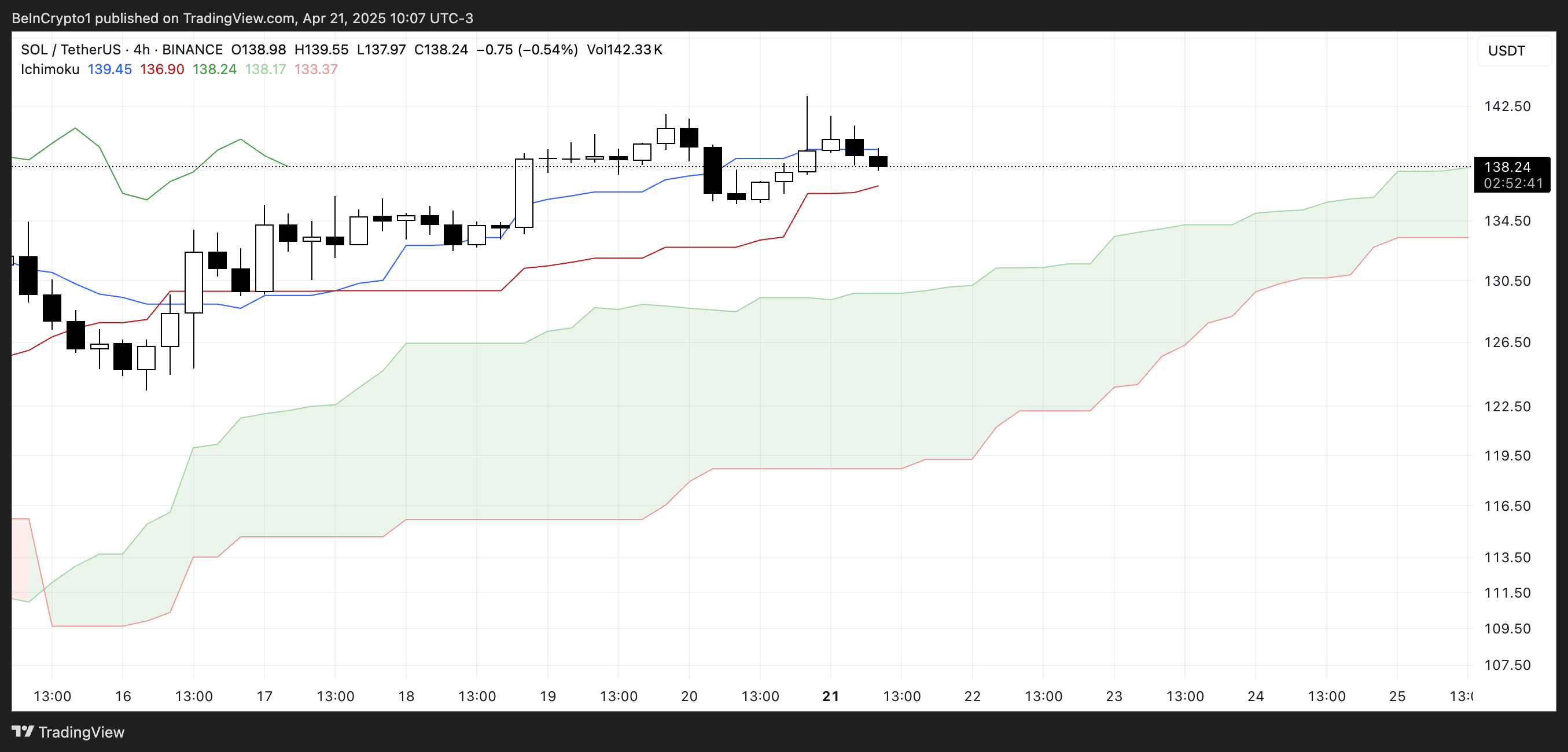
The overall Ichimoku structure remains bullish, with a thick, rising cloud and leading span A well above span B—indicating strong underlying support.
If Solana finds support at the Kijun-sen and climbs back above the Tenkan-sen, the uptrend could regain strength; otherwise, a test of the cloud’s upper boundary may follow.

Meanwhile, Solana’s BBTrend is currently at 6, extending nearly ten days in positive territory after peaking at 17.5 on April 14. The recent increase from 4.26 to 6 suggests renewed bullish momentum following a brief cooldown.
BBTrend, or Bollinger Band Trend, tracks the strength of price movement based on Bollinger Band expansion.
Positive values like the current one point to an active uptrend, and if the BBTrend continues to rise, it could signal stronger momentum and potential for another upward move.
Solana Dominates DEX Volume and Fee Generation as Meme Coins Drive Ecosystem Growth
Solana has once again claimed the top spot among all chains in DEX volume, recording $15.15 billion over the past seven days. The combined total of Ethereum, BNB, Base, and Arbitrum reached $22.7 billion.

In the last 24 hours alone, Solana saw $1.67 billion in volume, largely fueled by its booming meme coin ecosystem and the ongoing launchpad battle between PumpFun and Raydium. Adding to this good momentum, Solana recently surpassed Ethereum in Staking Market Cap.

When it comes to application fees, Solana’s momentum is just as clear. Four of the top ten fee-generating apps over the past week—PumpFun, Jupiter, Jito, and Meteora—are Solana-focused.
Pump leads the pack with nearly $18 million in fees alone.
Solana Breaks Key Resistance as Uptrend Targets Higher Levels, but Risks Remain
Solana has finally broken above its key resistance at $136, flipping it into a new support level that was successfully tested just yesterday.
Its EMA lines remain aligned in a bullish setup, suggesting the uptrend is still intact.
If this momentum continues, SOL price could aim for the next resistance zones at $147 and $152—levels that, if breached, open the door to a potential move toward $179.
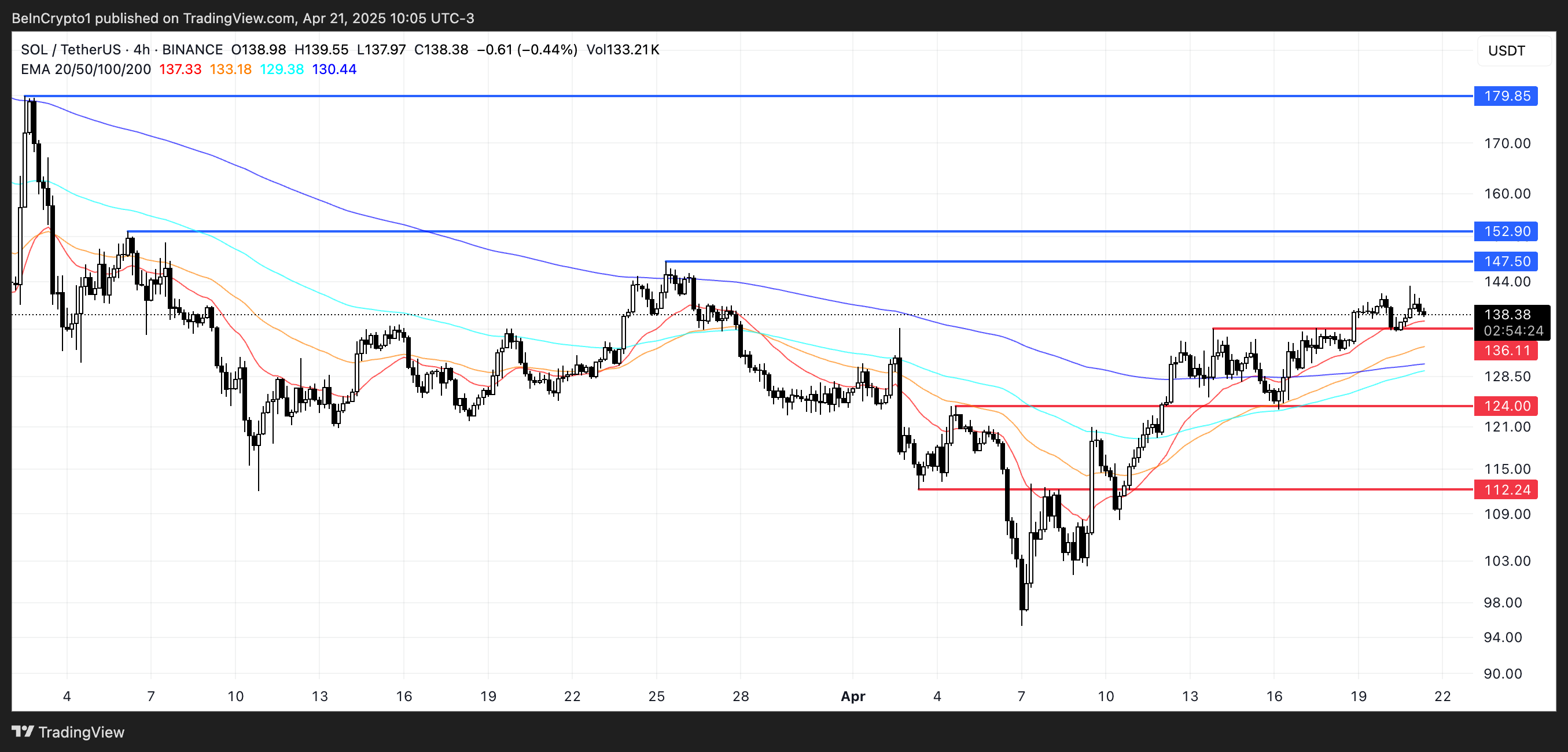
The current structure favors buyers, with higher lows and strong support reinforcing the trend.
However, if momentum fades, a retest of the $136 support is likely.
A breakdown below that level could shift sentiment, exposing Solana to deeper pullbacks toward $124 and even $112.
Disclaimer
In line with the Trust Project guidelines, this price analysis article is for informational purposes only and should not be considered financial or investment advice. BeInCrypto is committed to accurate, unbiased reporting, but market conditions are subject to change without notice. Always conduct your own research and consult with a professional before making any financial decisions. Please note that our Terms and Conditions, Privacy Policy, and Disclaimers have been updated.
Market
Crypto Firms Donated $85 million in Trump’s Inauguration
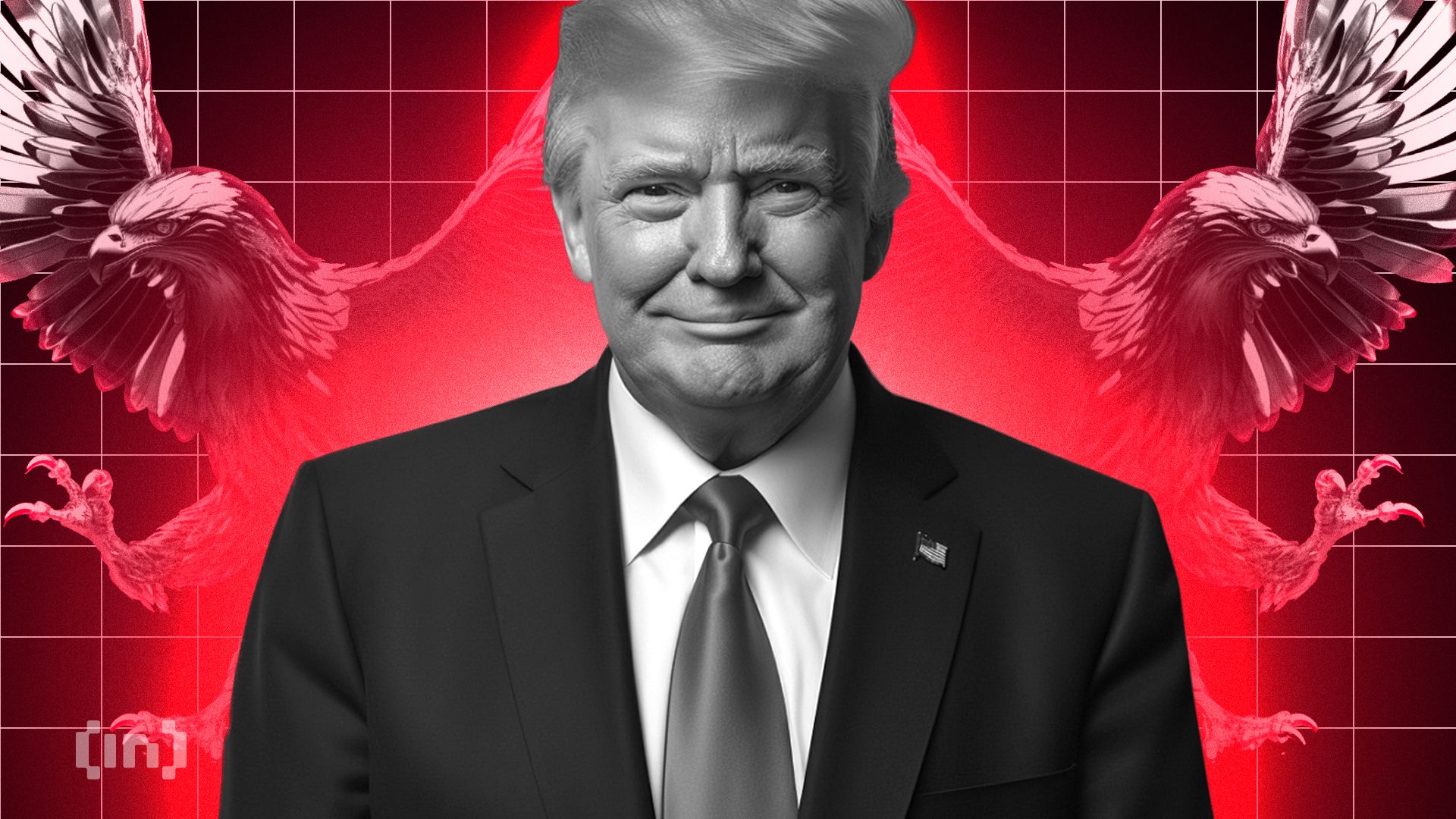
According to a new report, 15 firms and individuals from the crypto industry donated more than $100,000 to President Trump’s Inauguration, totaling over $85 million.
Almost all of these companies apparently received direct or indirect benefits from Trump’s administration. This includes dropped legal proceedings, lucrative business partnerships, participation in Trump’s Crypto Summit, and more.
Crypto Industry Went All-In on Trump’s Inauguration
Since promising to bring friendlier regulations on the campaign trail, Donald Trump attracted a reputation as the Crypto President.
Trump’s Inauguration festivities included a “Crypto Ball,” and several prominent firms made donations for these events. Today, a report has compiled all crypto-related contributions of over $100,000, revealing some interesting facts.

Since taking office, President Trump and his family have been allegedly involved in prominent crypto controversies, and these donations may be linked to several of them.
For example, eight of the donors, Coinbase, Crypto.com, Uniswap, Yuga Labs, Kraken, Ripple, Robinhood, and Consensys, had SEC investigations or lawsuits against them closed since Trump’s term began.
The commission might have dropped its probe against these companies anyway due to its changing stance on crypto enforcement. However, being in the President’s good books likely helped the process.
Further Alleged Benefits for Donors
In other words, nearly half the firms that made donations to Trump’s Inauguration have seen their legal problems cleared up quickly. This isn’t the only regulation-related benefit they allegedly received.
Circle, for example, recently made an IPO after openly stating that Trump’s Presidency made it possible. Galaxy Digital received SEC approval for a major reorganization, a key step for a NASDAQ listing.
Other donors, such as Crypto.com and ONDO, got more direct financial partnerships with businesses associated with the Trump family.
Previously, Ripple’s CEO, Brad Garlinghouse, anticipated a crypto bull market under Trump. Also, XRP, Solana, and Cardano were all unexpectedly included in the US Crypto Reserve announcement.
All three of these companies made major donations to Trump’s Inauguration.
It seems that most of the firms involved got at least some sort of noticeable benefit from these donations. Donors like Multicoin and Paradigm received invitations to Trump’s Crypto Summit, while much more prominent groups like the Ethereum Foundation got snubbed.
Meanwhile, various industry KOLs and community members have already alleged major corruption in Trump’s crypto connections.
While some allegations might lack substantial proof, the crypto space has changed dramatically under the new administration, for both good and bad.
Disclaimer
In adherence to the Trust Project guidelines, BeInCrypto is committed to unbiased, transparent reporting. This news article aims to provide accurate, timely information. However, readers are advised to verify facts independently and consult with a professional before making any decisions based on this content. Please note that our Terms and Conditions, Privacy Policy, and Disclaimers have been updated.


